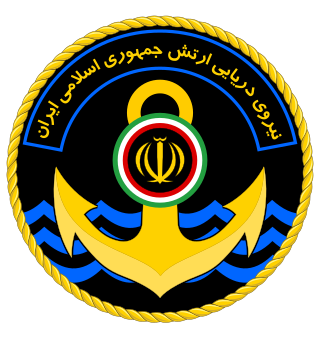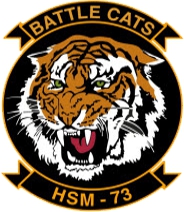
The RUR-5 ASROC is an all-weather, all sea-conditions anti-submarine missile system. Developed by the United States Navy in the 1950s, it was deployed in the 1960s, updated in the 1990s, and eventually installed on over 200 USN surface ships, specifically cruisers, destroyers, and frigates. The ASROC has been deployed on scores of warships of many other navies, including Canada, Germany, Italy, Japan, Taiwan, Greece, Pakistan and others.

The Los Angeles class of submarines are nuclear-powered fast attack submarines (SSN) in service with the United States Navy. Also known as the 688 class after the hull number of lead vessel USS Los Angeles (SSN-688), 62 were built from 1972 to 1996, the latter 23 to an improved 688i standard. As of 2024, 24 of the Los Angeles class remain in commission—more than any other class in the world—and they account for almost half of the U.S. Navy's 50 fast attack submarines.

A naval mine is a self-contained explosive device placed in water to damage or destroy surface ships or submarines. Similar to anti-personnel and other land mines, and unlike purpose launched naval depth charges, they are deposited and left to wait until, depending on their fuzing, they are triggered by the approach of or contact with any vessel.

USS Baton Rouge (SSN-689) was a Los Angeles-class nuclear-powered attack submarine which served with the United States Navy. With her keel laid down on 18 November 1972, Baton Rouge was launched on 26 April 1975. She became the second Los Angeles-class submarine to be commissioned, on 25 June 1977. In 1995, she was the first of her class to be decommissioned, after a collision with a Russian Sierra-class submarine.

USS Moosbrugger (DD-980) was a Spruance-class destroyer built for the United States Navy by the Ingalls Shipbuilding Division of Litton Industries at Pascagoula, Mississippi. Affectionately nicknamed the "Moose" by her crews, she was named in honor of Vice Admiral Frederick Moosbrugger who is best known for his service in World War II as a highly successful commander of destroyer squadrons.

Submarine warfare is one of the four divisions of underwater warfare, the others being anti-submarine warfare, mine warfare and mine countermeasures.

The Mark 48 and its improved Advanced Capability (ADCAP) variant are American heavyweight submarine-launched torpedoes. They were designed to sink deep-diving nuclear-powered submarines and high-performance surface ships.

The Mark 46 torpedo is the backbone of the United States Navy's lightweight anti-submarine warfare torpedo inventory and is the NATO standard. These aerial torpedoes are designed to attack high-performance submarines. In 1989, an improvement program for the Mod 5 to the Mod 5A and Mod 5A(S) increased its shallow-water performance. The Mark 46 was initially developed as Research Torpedo Concept I, one of several weapons recommended for implementation by Project Nobska, a 1956 summer study on submarine warfare.

The SEAL Delivery Vehicle (SDV) is a crewed submersible and a type of swimmer delivery vehicle used to deliver United States Navy SEALs and their equipment for special operations missions. It is operated by SEAL Delivery Vehicle Teams.

USS Bluefish (SSN-675), a Sturgeon-class attack submarine, was the second ship of the United States Navy to be named for the bluefish.

USS Sunfish (SSN-649), a Sturgeon-class attack submarine, was the second ship of the United States Navy to be named for the ocean sunfish, a marine species having a deep body truncated behind, and high dorsal and anal fins.

USS Trumpetfish (SS-425), a Balao-class submarine, was the only ship of the United States Navy to be named for trumpetfish, any of several fishes so-called for their deep, compressed body and long, tubular snout. Her keel was laid down on 23 August 1943 at Philadelphia by the Cramp Shipbuilding Company. She was launched on 13 May 1945 sponsored by Mrs. Oswald S. Colclough, and commissioned on 29 January 1946.

USS Jacksonville (SSN-699), a nuclear powered Los Angeles-class attack submarine, is the only vessel of the United States Navy to be named for Jacksonville, Florida.

USS Cusk (SS/SSG/AGSS-348), a Balao-class submarine of the United States Navy named for the cusk, a large food fish related to the cod.
The names of commissioned ships of the United States Navy all start with USS, for United States Ship. Non-commissioned, primarily civilian-crewed vessels of the U.S. Navy under the Military Sealift Command have names that begin with USNS, standing for United States Naval Ship. A letter-based hull classification symbol is used to designate a vessel's type. The names of ships are selected by the Secretary of the Navy. The names are those of states, cities, towns, important persons, important locations, famous battles, fish, and ideals. Usually, different types of ships have names originated from different types of sources.

The Islamic Republic of Iran Navy or Iranian Navy, officially abbreviated NEDAJA, is the naval warfare service branch of Iran's regular military, the Islamic Republic of Iran Army (Artesh). It is one of Iran's two maritime military branches, alongside the Navy of the Islamic Revolutionary Guard Corps (IRGC).

Anti-submarine warfare is a branch of underwater warfare that uses surface warships, aircraft, submarines, or other platforms, to find, track, and deter, damage, or destroy enemy submarines. Such operations are typically carried out to protect friendly shipping and coastal facilities from submarine attacks and to overcome blockades.

The Mark 37 torpedo is a torpedo with electrical propulsion, developed for the US Navy after World War II. It entered service with the US Navy in the early 1950s, with over 3,300 produced. It was phased out of service with the US Navy during the 1970s, and the stockpiles were sold to foreign navies.

Anti-surface warfare is the branch of naval warfare concerned with the suppression of surface combatants. More generally, it is any weapons, sensors, or operations intended to attack or limit the effectiveness of an adversary's surface ships. Before the adoption of the submarine and naval aviation, all naval warfare consisted of anti-surface warfare. The distinct concept of an anti-surface warfare capability emerged after World War II, and literature on the subject as a distinct discipline is inherently dominated by the dynamics of the Cold War.

Helicopter Maritime Strike Squadron 73 (HSM-73) is a United States Navy Maritime Strike helicopter squadron based on Naval Air Station North Island, California.



















